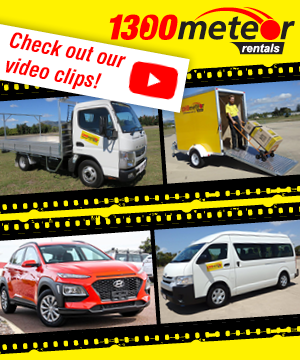Driving tips for Trucks and Buses
The following driving tips are based on our experiences with operating rental trucks and buses over many years and will enable you to avoid the more common and easily avoidable causes of damage to this vehicle type.
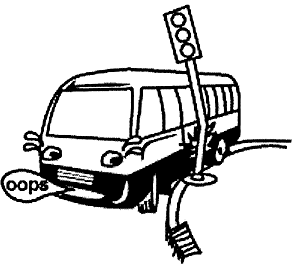 Cutting Corners
Cutting Corners
Most of our trucks and larger buses, from the Toyota Commuter 12/14 seaters on up, all feature a LONG WHEEL BASE ie: the measurement from the front axle to the rear axle is long, especially when compared to a car.
When turning, it must be remembered that the rear wheels turn inside the line of the front wheels. For this reason it is vital not to 'cut' or turn corners too sharply/tightly.
If corners are cut (particularly the left handed variety) the rear wheel may strike the kerb, or if there is a structure such as a pole in close proximity to the apex of the corner, there is a good chance that the side of the vehicle will come into contact with same.
In summary, don't cut corners, but rather take a more conservative and safer line around the corner.
Long journey? Plan responsibly, and take rest breaks!
 Planning a long trip? Don't be overly ambitious - set realistic and safe daily travel targets and certainly no more than 800 1,000kms or 12 hours of driving per day.
Planning a long trip? Don't be overly ambitious - set realistic and safe daily travel targets and certainly no more than 800 1,000kms or 12 hours of driving per day.
The photo opposite shows what can happen if you fall asleep at the wheel! Luckily in this particular case the driver was able to walk away uninjured, and no other vehicle was involved! It could have been much, much worse!
The moral of this story is that if you are embarking on a long trip it is important to get a good nights' sleep the night before and during your journey, and to take regular rest breaks every few hours along the road.
If you find yourself nodding off while driving don't try to fight it but instead recognise what your body is telling you - pull up instead (once a suitable and safe pullover can be found) otherwise there is every chance of falling asleep at the wheel, with unwelcome consequences.
Roof damage
Experience tells us that clients more accustomed to driving cars from day to day are more likely to forget the overall height of our trucks and buses and drive under a low structure, resulting in roof damage.
Examples of low structures include low branches to trees, under cover car parks with a restricted head height (usually around 1.95M), awning roofs and carports to motels and the like.
The nominal overall height of our trucks and buses when empty can be found on a sticker we provide for this purpose on the inside of the windscreen, in front of the drivers position. An indication of heights is as follows: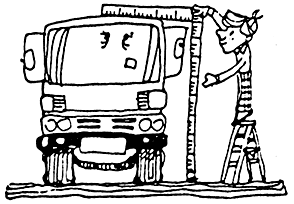
Ssangyong Stavic
7 seater | 1815mm |
Toyota Commuter
12/14 seater | 2285mm |
Toyota Coaster
21 seater | 2755mm |
Mitsubishi Rosa
25 seater | 2630mm |
| Trucks | from: 2800mm (1.5 tonners)
to: 3750mm (8/9 tonners) |
We have also found situations where a fully loaded bus has been able to drive under and clear a low roof, only to strike it later on when the driver goes to move the bus when empty! In other words, the overall height varies depending on whether the bus is loaded or empty.
Roof damage is always expensive to repair, and as we require (as do most rental car companies) the client to reimburse in full for any such damage, please LOOK UP!
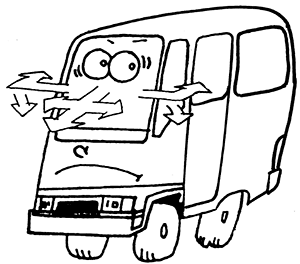 Reversing damage
Reversing damage
Reversing damage is quite prevalent, more so when a trailer is attached. Such damage can be avoided by:
- removing the trailer before reversing - this will eliminate the possibility of jack-knifing. Alternatively, have someone guide the driver.
- checking the immediate area around and behind the vehicle using the side mirrors. If unsure what is behind the vehicle the driver should get out and inspect first hand. Alternatively have someone guide the driver whilst standing in the driver's field of vision (and never behind the vehicle).
Water Damage
While truck air intakes are generally mounted high, the radiator and fan to our 'cab over' vehicles are positioned very low. Travelling through water above the level of the front bumper may result in the fan sucking into and holing the radiator.
DO NOT ATTEMPT TO TRAVERSE WATER CROSSINGS
Water does not compress. If the engine takes in water, internal damage will occur and an overhaul will be required. Immersion in water can also damage electrical components and contaminate lubricants to the engine, gearbox, differential and wheel bearings.
Damage by water immersion is always very expensive to repair. Most if not all rental companies (including ours) require the client to reimburse in full for any such damage.
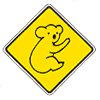 Animal Damage
Animal Damage
Long journeys overnight in country areas greatly increases the risk of striking an animal - travelling during daylight hours is safest. If you see an animal on or near the road - SLOW DOWN - you can never tell which way they are going to go.
If you have the headlights on during darkness or early morning and see a kangaroo or wallaby ahead of the vehicle heading for the bush, don't assume that it is gone and the danger is over.
Slow right down, as in these situations animals become confused by the headlights and more often than not will turn straight around and come back towards the vehicle.
Should you swerve to avoid an animal on the road, or run it over? In this day and age of environmental concern most people would probably try and avoid the animal. In practice this is not necessarily the best course of action.
Sudden manoeuvres such as swerving can (and very often does) lead to the loss of control of the vehicle resulting in an accident and injuries. With this in mind, whose life is more important - the animal or yours and that of your passengers?
Obviously if a
large animal such as a horse or cow is on the road and you can't stop in time the driver must
brake hard and attempt to avoid a collision. In this situation make sure it is safe to run off the road (to the left), and avoid reefing the steering wheel as it may well lead to the loss of control altogether.
With smaller animals such as dogs, wallabies and kangaroos where a collision is imminent it may well be best to brake hard and hope for the best if the animal is struck. The alternative of savagely turning the steering wheel in a vain last minute attempt to miss the animal is courting disaster, especially if there is oncoming traffic, or the roadside is not safe for pulling over.
 Steep Decents
Steep Decents
Total reliance upon the vehicles' service brakes to negotiate long downhill runs may lead to their overheating and possible failure, more so on the larger vehicles.
Ways of alleviating this possibility include:
- selecting a lower gear (before starting your run downhill), so that the engine acts as a brake - as a guide select the same gear for going down as you used coming up.
- if the vehicle is fitted with an exhaust brake (most of our trucks, and our Coaster 21 seat buses) make sure it is switched on - these devices are generally set to operate automatically when the driver's foot is off the throttle.
Warning: Never descend on any downhill run (short or long) with the gear box in neutral - with no engine braking whatsoever the vehicle will quickly run away and greatly increase the risk of the driver losing control.
Loading of Cargo
Distribute weight evenly |  |
Avoid high loads |  |
Avoid point loading |  |
Avoid point loading |  |
Secure tarps |  |
Please keep these tips in mind and have a safe journey!
Disclaimer: The information contained on this site is general and is not intended to be advice on any matter. Nothing contained herein is intended to constitute an offer, inducement, promise or contract of any kind. Please refer to the terms and conditions of this website for further information.


)
)
)
)
)
)
)
)
)

 Cutting Corners
Cutting Corners Planning a long trip? Don't be overly ambitious - set realistic and safe daily travel targets and certainly no more than 800 1,000kms or 12 hours of driving per day.
Planning a long trip? Don't be overly ambitious - set realistic and safe daily travel targets and certainly no more than 800 1,000kms or 12 hours of driving per day.
 Reversing damage
Reversing damage Animal Damage
Animal Damage Steep Decents
Steep Decents




